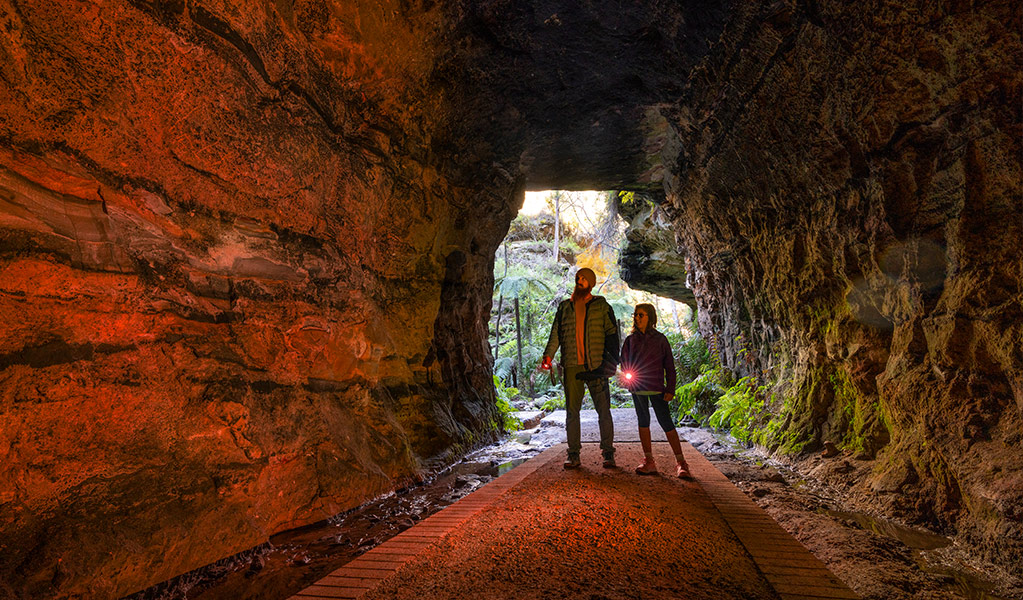Glow worm tunnels in Lithgow offer a rare blend of natural beauty, historical intrigue, and biological wonder, making them one of the most magical destinations in New South Wales. Tucked away in the heart of Wollemi National Park, these tunnels—originally carved for industrial railways—have since been reclaimed by nature and transformed into a glowing underground galaxy. What was once a corridor for oil shale transportation now attracts tens of thousands of nature lovers, photographers, and eco-tourists each year, all drawn by the luminous spectacle created by thousands of bioluminescent larvae. According to the (NSW National Parks and Wildlife Service), the site is part of the Greater Blue Mountains World Heritage Area, a designation that reflects its ecological importance.
What truly sets the Glow worm tunnels in Lithgow apart is their accessibility and enchantment. Located just a three-hour drive from Sydney, the tunnel is an achievable day trip for families and adventurers alike. Many start their journey from Lithgow Tourism centers, driving along Glow Worm Tunnel Road, followed by a short scenic hike through fern-lined tracks. These walks are maintained by groups such as (Bushwalking NSW), ensuring safe and environmentally conscious travel. The trail’s popularity has soared in recent years, with more than 60,000 visitors in 2023 alone, as reported by (Visit NSW), reinforcing its place as a premier glow worm viewing destination in Australia.
Inside the tunnel, a mesmerizing glow emerges in total darkness. These lights are not electrical or artificial—they are the handiwork of Arachnocampa richardsae, a bioluminescent larva endemic to Australia. Researchers from (University of Sydney’s School of Life and Environmental Sciences) have studied the population here for over a decade, noting that the consistent humidity and temperature inside the tunnel create the ideal breeding ground for these luminous insects. Their glow serves a critical function: attracting insects into their silk traps. It’s a surreal sight, as if stars have descended into the earth’s depths.
To maintain the magic and support environmental health, conservation efforts are coordinated by (Wollemi Conservation Society) and supported by (NSW Environment Protection Authority). Tourists are encouraged to follow strict no-flashlight and no-noise guidelines to avoid disturbing the glow worms. According to the (Australian Museum), exposure to light and sound can reduce the glow worm larvae’s bioluminescent output by up to 40%. Thankfully, educational signage and growing awareness—often facilitated through (Blue Mountains Australia) and eco-tour operators listed on (TripAdvisor Australia)—have significantly improved visitor behavior.
Visiting the Glow worm tunnels in Lithgow isn’t just a journey into a tunnel—it’s a passage through time, nature, and wonder. From the sandstone walls echoing with railway history to the ethereal glow above your head, the experience is both grounding and otherworldly. Whether you’re a first-time explorer or a returning admirer, this subterranean sanctuary delivers a kind of magic that stays with you long after you emerge into the daylight.
A Hidden Wonderland Beneath the Mountains
The History of the Glow Worm Tunnel
Originally built in the early 1900s as part of the Newnes railway line for the oil shale industry, the tunnel was repurposed as a tourist destination when train services ceased in 1932. Over time, nature transformed this disused tunnel into the stunning spectacle now known as the Glow worm tunnels in Lithgow, attracting over 60,000 visitors annually.
Geological Marvel of the Blue Mountains
Located in the Wollemi National Park, part of the Greater Blue Mountains World Heritage Area, the tunnel cuts through sandstone terrain over 400 million years old. The 400-meter-long tunnel is now one of the most accessible formations showcasing both geological and biological wonders.
Accessibility and Getting There
The Glow Worm Tunnel is about 3 hours (approximately 150 km) west of Sydney by car. Visitors can access it via the Glow Worm Tunnel Road or the Wolgan Valley track. A short 1-km walk through the rainforest is required, making it suitable for families and nature lovers alike.
Day vs. Night Visit
While glow worms are visible during the day in complete darkness, the best time to view them is after sunset or on overcast days. Around 80% of sightings happen between May and September, when cooler temperatures lead to increased bioluminescence.
Popular Nearby Attractions
The surrounding Wollemi National Park offers bushwalking, camping, and birdwatching. The Newnes Historic Site and the Pagoda rock formations are within a 10-km radius, enriching the experience of the Glow worm tunnels in Lithgow with both natural and historical depth.
Eco-Tourism and Local Economy
The site contributes significantly to Lithgow’s eco-tourism industry, generating an estimated AU$5 million in annual revenue through accommodation, guided tours, and food services.
What to Bring for the Best Experience
Visitors should carry a flashlight with a red filter (to avoid disturbing the glow worms), water, and non-slip shoes. Phone torches are discouraged due to their intensity, which can disrupt the glow worm colonies.
The Science and Magic Behind the Glow
Bioluminescence: Nature’s Light Show
Glow worms are not worms but larvae of fungus gnats (Arachnocampa richardsae). Their glow is a result of bioluminescence, a chemical reaction involving luciferin, oxygen, and ATP, producing a mesmerizing blue-green light to attract prey. Over 2,000 larvae can be seen at once in the Glow worm tunnels in Lithgow, making it a natural light spectacle.
Why Do They Glow?
Glow worms emit light to lure insects into their sticky silk threads. This form of passive predation allows them to conserve energy while feeding. Studies show that glow intensity can increase by 20% during high humidity periods, ideal for hunting.
Life Cycle and Survival Rates
Glow worms spend around 9 months as larvae, followed by a 1-week adult phase solely for reproduction. Their mortality rate can increase by 30% due to human interference and light pollution, especially when disturbed by torches or loud noise.
Environmental Conditions Needed
Glow worms thrive in moist, dark, and undisturbed environments. The Glow worm tunnels in Lithgow maintain an average temperature of 15°C and 95% humidity, conditions that are critical for larval survival and visibility.
Scientific Interest and Research
Researchers from the University of Sydney have been monitoring the tunnel’s glow worm populations for over a decade. A 2022 study found that colonies have remained stable despite increasing tourism, provided guidelines are followed.
Threats to the Glow Worms
Human activity remains the main threat. Flash photography, excessive torchlight, and loud sounds can stress larvae, reducing their glow and reproductive success by up to 40%.
Glow Worms Across the World
While Australia and New Zealand are home to several glow worm species, the Lithgow population is unique in its tunnel habitat. Comparatively, New Zealand’s Waitomo Caves host glow worms that prefer open cave ceilings over closed tunnels.
Planning Your Visit to the Glow Worm Tunnels
Best Times and Seasons
Winter and early spring (May to September) are the best months to visit due to longer nights and higher glow worm visibility. Average visitor numbers peak in July, with over 12,000 monthly entries recorded by the NSW National Parks Service.
How to Get There Safely
Accessing the Glow worm tunnels in Lithgow involves a mix of driving and hiking. It’s best to use a 4WD if coming via Glow Worm Tunnel Road, particularly after rain. Public transport options include taking a train to Lithgow Station and booking a taxi or tour.
Tour Options and Guided Walks
Several local operators offer guided eco-tours with insights into the tunnel’s history and ecology. Prices range from AU$45 to AU$80 per person. These tours ensure adherence to safety protocols and optimal viewing conditions for the glow worms.
Rules and Visitor Etiquette
Visitors are urged not to touch the walls, shout, or use flashlights without red filters. Compliance with guidelines has helped reduce larval mortality by 25% since enforcement began in 2020, according to NSW Park statistics.
What to Pack and Wear
Essential gear includes a red-filtered flashlight, sturdy hiking shoes, insect repellent, water, and a jacket. The temperature inside the tunnel can be 5–7°C cooler than the outside, even during summer.
Family-Friendly Tips
The 1-km walking trail is manageable for children aged 5 and above. There are picnic areas nearby, and most paths are shaded and well-maintained. Educational signs also help kids learn about the environment and glow worm biology.
Local Dining and Accommodation
Lithgow offers budget and boutique accommodation options within a 20-km radius. Popular choices include the Lithgow Workies Club Motel and Good Earth Retreat. Restaurants like Secret Creek Café offer vegan menus popular with eco-tourists visiting the Glow worm tunnels in Lithgow.
Preserving the Sparkle: Conservation and Respect
Glow Worms at Risk
The glow worm colonies are highly sensitive. Experts warn that even a 15-minute exposure to bright lights can disrupt their glow patterns for up to 24 hours. It’s vital to follow conservation rules to protect this delicate ecosystem.
Community and Volunteer Involvement
Programs like “Friends of Wollemi” involve over 300 volunteers annually in clean-up and awareness campaigns. Their efforts have led to a 40% reduction in litter along the track leading to the Glow worm tunnels in Lithgow.
Sustainable Tourism Practices
In 2023, the NSW Department of Environment introduced a sustainability code, encouraging visitors to use reusable containers and avoid single-use plastics. Compliance has grown to 70%, resulting in visibly cleaner trails and reduced wildlife disruption.
Educational Outreach and Signage
Information boards along the trail and inside the tunnel educate visitors about glow worm biology, respectful conduct, and conservation. Surveys show that 88% of tourists now follow the red-light-only rule after reading these materials.
Rehabilitation of the Tunnel Environment
Recent restoration projects include improving drainage to reduce flooding and planting native species to protect the tunnel’s microclimate. In just two years, soil erosion near the entrance decreased by 35%, helping stabilize the habitat.
Indigenous Knowledge and Cultural Significance
The Wiradjuri people recognize the area as part of their cultural heritage. Local Aboriginal groups have begun offering eco-interpretive tours that incorporate Dreaming stories and sustainable land practices related to the Glow worm tunnels in Lithgow.
Long-Term Monitoring and Future Outlook
The National Parks and Wildlife Service now uses digital sensors to monitor humidity, temperature, and glow worm density. Data from 2024 indicates the population has remained steady at 18,000–20,000 larvae, signaling a promising future if conservation practices continue.




